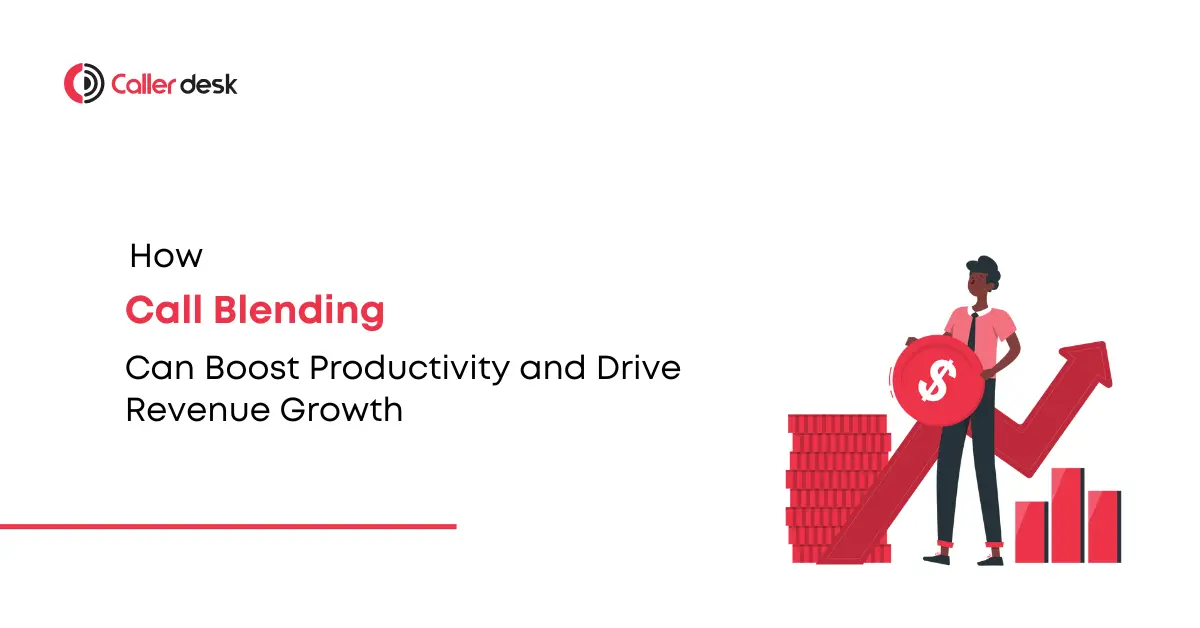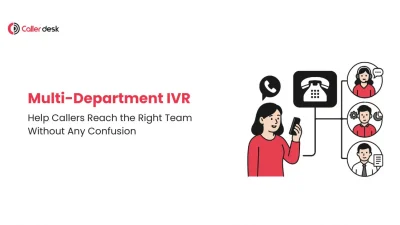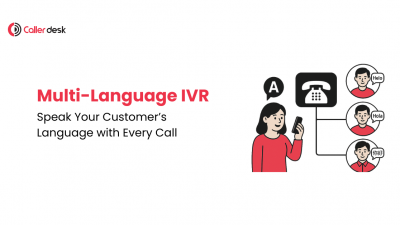Balancing efficiency and revenue growth in call centers has always been a challenging task. Call centers often face the dilemma of managing high call volumes for customer support while ensuring outbound sales campaigns run smoothly. A smart and effective solution to address this is call blending, which bridges the gap between inbound and outbound tasks. By dynamically adjusting workloads, call blending ensures agents are always engaged, leading to improved productivity, enhanced customer experience, and significant revenue growth.
Whether your goal is to maximize agent performance, reduce downtime, or leverage customer interactions for upselling opportunities, call blending can revolutionize your call center operations. This article explores how call blending works, the ways it boosts productivity, and its impact on driving business growth.
What is Call Blending?
Call blending is a technique that allows call center agents to manage both inbound and outbound calls seamlessly. It eliminates the traditional segregation of inbound and outbound teams by using intelligent systems that automatically adjust call assignments based on real-time demand.
How Call Blending Works:
- Inbound Calls: Agents handle incoming queries, such as support requests or general inquiries, ensuring customers receive timely assistance.
- Outbound Calls: When inbound traffic decreases, agents switch to outbound activities like follow-ups, sales pitches, or surveys.
- Dynamic Adjustment: A predictive dialer balances the workload, reducing idle time and optimizing agent productivity.
Example: An e-commerce business can use call blending to manage inbound queries during sales events while running outbound campaigns to follow up with cart abandoners.
How Call Blending Boosts Productivity
1. Maximizing Agent Utilization
Agents spend more time actively engaging with customers and less time waiting for calls. By dynamically assigning tasks, call blending ensures no downtime, boosting overall efficiency.
- Impact: Studies show call blending can reduce agent idle time by up to 40%, significantly increasing productivity.
- Use Case: A retail company uses call blending to handle peak inbound queries during sales while utilizing downtime for outbound feedback collection.
2. Proactive Customer Engagement
Call blending empowers agents to proactively connect with customers, addressing their needs before they escalate into problems.
- Follow-Up Calls: Agents can follow up on unresolved issues, improving resolution rates.
- Proactive Support: During low inbound periods, agents can reach out to customers for feedback, fostering loyalty and improving the brand image.
3. Reducing Monotony for Agents
Repetitive tasks can lead to burnout and reduced job satisfaction among agents. Call blending introduces variety by allowing agents to switch between inbound and outbound tasks.
- Agent Morale: Engaged and motivated agents perform better, resulting in higher efficiency and lower turnover rates.
How Call Blending Drives Revenue Growth
1. More Sales Opportunities
Call blending turns every interaction into an opportunity. During inbound calls, agents can upsell or cross-sell products and services, while outbound calls focus on lead generation and follow-ups.
- Example: A telecom provider can upsell a premium package during an inbound billing query or follow up with leads from a recent marketing campaign.
- Impact: Businesses leveraging call blending have reported up to a 25% increase in sales conversions.
2. Efficient Campaign Management
Call blending allows businesses to manage multiple campaigns simultaneously without overburdening agents or requiring additional resources.
- Cost Efficiency: By utilizing existing agents for both inbound and outbound tasks, businesses reduce overhead costs while maintaining performance.
- Scalability: As your campaigns grow, call blending ensures agents can handle increased workloads without compromising service quality.
3. Improved Customer Experience (CX)
Happy customers are more likely to return and recommend your services. Call blending directly contributes to CX by ensuring faster response times and personalized interactions.
- For Inbound Calls: Reduced wait times and quick resolutions enhance satisfaction.
- For Outbound Calls: Personalized follow-ups based on previous interactions strengthen customer relationships.
Key Features of Effective Call Blending Software
When selecting call blending software, look for tools that align with your business needs. Advanced features can significantly impact performance and revenue.
1. Intelligent Call Routing
- Ensures calls are directed to the most suitable agents based on skill, availability, or priority.
- Result: Faster resolutions and improved customer satisfaction.
2. Real-Time Analytics
- Tracks agent performance, call volumes, and conversion rates.
- Impact: Helps managers make data-driven decisions to optimize workflows.
3. CRM Integration
- Connects seamlessly with CRM platforms like Salesforce, HubSpot, and Zoho.
- Benefit: Agents access customer profiles during calls, enabling personalized interactions.
4. Omnichannel Support
- Handles calls, chats, emails, and social media interactions through a single platform.
- Impact: Creates a consistent experience across all communication channels.
Real-World Applications of Call Blending
1. Lead Nurturing Campaigns
- Agents follow up with leads from marketing campaigns during downtime, maximizing ROI.
2. Product Promotions
- During inbound queries, agents can promote complementary products or services, increasing sales.
3. Service Renewals
- Agents handle inbound renewal requests while reaching out to customers nearing subscription expiry.
Why Choose CallerDesk for Call Blending?
CallerDesk offers a comprehensive, cloud-based solution for businesses seeking to optimize call center operations.
Key Features Include:
- Seamless CRM Integration: Ensure real-time data sharing for personalized interactions.
- Advanced Analytics: Gain insights into call center performance and customer behavior.
- Scalability: Easily adapt to growing business needs without disrupting operations.
- Proven Results: Clients report up to a 30% increase in agent productivity and a 20% boost in revenue within months.
Conclusion
Call blending isn’t just a strategy—it’s a necessity for modern call centers. By keeping agents engaged, improving customer satisfaction, and creating more sales opportunities, it ensures sustainable growth for businesses.
If you’re ready to take your call center operations to the next level, CallerDesk’s call blending solutions provide the tools and features you need to succeed.
Take the first step today! Schedule a free demo with CallerDesk and experience how call blending can transform your business.
Frequently asked questions
1. What is Call Blending in a Call Center?
Call blending allows agents to handle both inbound (customer service) and outbound (sales, follow-up) calls seamlessly. Using a predictive dialer, the system dynamically adjusts call assignments based on real-time demand, ensuring agents stay productive and customers receive timely service.
2. How Does Call Blending Improve Agent Productivity?
Call blending minimizes idle time by keeping agents engaged with outbound tasks during low inbound call volumes and vice versa. This ensures optimal use of agent time and boosts overall productivity.
3. What Are the Benefits of Call Blending?
Key benefits include increased efficiency, higher customer satisfaction, more sales opportunities, reduced operational costs, and better agent engagement. It creates a seamless experience for customers and businesses alike.
4. Can Call Blending Drive Revenue Growth?
Yes, call blending enables agents to handle sales and support calls, turning every interaction into a revenue opportunity through upselling, cross-selling, and lead follow-ups.
5. How Does Call Blending Work with CRM Integration?
With CRM integration, agents can access real-time customer data, such as purchase history and preferences, enabling personalized service during inbound and outbound calls.
6. What Features Should I Look for in Call Blending Software?
Key features include intelligent call routing, real-time analytics, CRM integration, omnichannel support, and scalability. These features ensure smooth operations and better customer service.
7. How Does Call Blending Impact Customer Satisfaction?
By reducing wait times, resolving queries faster, and offering personalized solutions, call blending enhances the overall customer experience and builds stronger relationships.
8. Is Call Blending Suitable for Small Businesses?
Absolutely! Call blending helps small businesses optimize resources, reduce costs, and scale easily without the need for separate inbound and outbound teams.
9. Why Should I Choose CallerDesk for Call Blending?
CallerDesk provides advanced call blending solutions with intelligent routing, CRM integration, and real-time analytics. Its scalable platform ensures consistent performance, making it a trusted choice for businesses of all sizes.
10. How Can I Get Started with Call Blending?
Schedule a free demo with CallerDesk to explore how its call blending solution can transform your operations. CallerDesk ensures seamless implementation, robust support, and improved call center efficiency.





